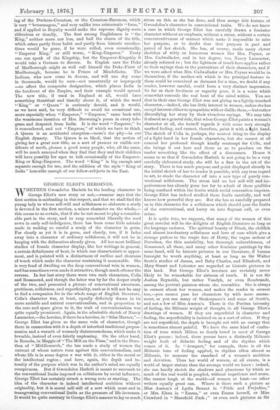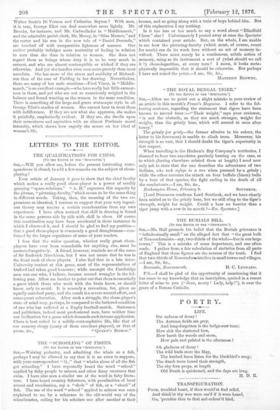GEORGE ELIOT'S HEROINES.
WHETHER Gwendolen Harleth be the leading character in
George Eliot's new story or not,—rumour says that the first section is misleading in this respect, and that we shall find the young lady to whose self-will and selfishness so elaborate a study is devoted in the first section, a minor character on the whole,— this seems to us certain, that if she be not meant to play a consider- able part in the story, and to reap somewhat liberally the seed sown in early self-indulgence, there has been some little mistake made in making so careful a study of the character in germ. For clearly as yet it is in germ, and clearly, too, if it fades away into a character of ordinary selfishness, it will not be in keeping with the delineation already given. All her most brilliant studies of female character display, like her writings in general, a certain definiteness of bent, in which one characteristic is upper- most, and is painted with a distinctness of outline and clearness of touch which make the character containing it memorable. She is very fond of dwelling on the deep conventional vein in women, and has sometimes even made it attractive, though much oftener the reverse. In her last story there were two such characters, Celia and Rosamond, and though the latter was by far the deeper study of the two, and presented a picture of conventional sweetness, prettiness, selfishness, and superficiality, such as it will not be easy to find a companion for in the whole range of English literature, Celia's character was, at least, equally definitely drawn in its more amiable and natural conventionalism, and in proportion to the care and space given to it, the trait of conventionalism was quite equally prominent. Again, in the admirable sketch of Nancy Lammeter,—the heroine, if there be a heroine, in " Silas Marner,"— George Eliot has given us the same vein of character, though there in connection with it a depth of inherited traditional prepos- session and a warmth of womanly disinterestedness, which make it loveable, instead of even faintly unpleasing. On the other hand, in Romola, in' Maggie of The Mill on the Floss," and in the Doro- thea of " Middlemarch," she has made a study of women the current of whose nature runs against this conventionalism, and whose life is in some degree a war with it, either in the moral or the intellectual region ; and here, again, the depth and in- tensity of the purpose which was in the author's mind are equally conspicuous. But if Gwendolen Harleth is meant to succumb to the conventional limits imposed on selfishness by social influence, George Eliot has certainly struck a wrong note at starting. The idea of the character is indeed intellectual ambition without originality, but it is moral self-will of a sort which must end in transgressing conventional limits as the pressure of life increases. It would be quite contrary to George Eliot's manner to lay so much stress on this as she has done, and then merge this feature of Gwendolen's character in conventional traits. We do not know a case in which George Eliot has carefully drawn a feminine character without an emphasis, without a stress, without a certain concentrativeness of manner which make it impossible to miss her purpose, or to doubt that that purpose is part and parcel of her sketch. She has, of course, made many clever sketches of witty or humorous women like Mrs. Poyser, or Mrs. Cadwallader, and in her degree, too, Nancy Lammeter, already referred to ; but the lightness of touch here applies rather to their sayings than to the portraiture of their characters, and if we were asked what Mrs. Cadwallader or Mrs. Poyser would be in themselves, if the mother-wit which is the principal feature in them could be conceived as dormant for a time, we doubt if any reader, however careful, could form a very distinct impression. So far as their liveliness or sagacity goes, it is a voice which somewhat conceals the real bent of the mind within. You see that in their case George Eliot was not giving us a lightly-touched character,—indeed, she has little interest in women, unless she has enough interest either to sympathise with or dislike them,—butrather diversifying her story by their vivacious sayings. We may take it almost as a general rule, that when George Eliot paints a woman's character at all, she herself regards it with some very strongly marked feeling, and cannot, therefore, paint it with a light hand. The sketch of Celia is, perhaps, the nearest thing to the display of a light hand in her female characters, but she cannot at all conceal her profound though kindly contempt for Celia, and she brings it out here and there so as to produce on the reader something like the effect of a dissonance. Hence it seems to us that if Gwendolen Harleth is not going to be a very carefully elaborated study, she will be a flaw in the art of the story. There is too much purpose and point displayed already in the initial sketch of her to render it possible, with any true regard to art, to shade the character off into a new type of purely con- ventional selfishness. The stress laid on her self-will and im- periousness has already gone too far to admit of these qualities being confined within the limits which social convention imposes. George Eliot has indeed studied these limits carefully, and well knows how powerful they are. But she has as carefully prepared us in this character for a selfishness which should pass the limits of the conventional, and hurry on into flagrant evil, or even crime.
It is quite true, we suppose, that many of the women of this great novelist will be the delights of English literature as long as the language endures. The spiritual beauty of Dinah, the childish and almost involuntary selfishness and love of ease which give a strange pathos to the tragic fate of Hetty, the vague ardour of Dorothea, the thin amiability, but thorough unlovableness, of Rosamond, all these, and many other feminine paintings by the same hand, will be historic pictures in our literature, if human foresight be worth anything, at least as long as Sir Walter Scott's studies of James, and Baby Charles, and Elizabeth, and Mary Stuart and Leicester are regarded as historic pictures in this land. But George Eliot's heroines are certainly never likely to be remarkable for airiness of touch. It is not Sir Joshua Reynolds, but rather Vandyk, or even Rembrandt, among the portrait painters whom she resembles. She is always in earnest about her women, and makes the reader in earnest too,—you cannot pass her characters by with mere amuse- ment, as you can many of Shakespeare's and some of Scott's, and not a few of Miss Austen's. There is the Puritan intensity of feeling, the Miltonic weight of thought, in all George Eliot's drawings of women. If they are superficial in character and feeling, the superficiality is insisted on as a sort of crime. If they are not superficial, the depth is brought out with an energy that is sometimes almost painful. We have the same kind of exalta- tion of tone which Milton so dearly loved in moat of George Eliot's poems ; indeed, these poems have a distinctly Miltonic weight both of didactic feeling and of the rhythm which comes of it. In " Armgart," for example, there is all the Miltonic tone of feeling applied, in rhythm often almost as Miltonic, to measure the standard of a woman's ambition and devotion. Thus her world of women, at all events, is a world of larger stature than the average world we know ; indeed, she can hardly sketch the shadows and phantoms by which so much of the real world is peopled, without impatience and scorn. She cannot laugh at the world—of women at least—as other writers equally great can. Where is there such a picture as Miss Austen's of Lydia Bennet in "Pride and Prejudice," or Mrs. Elton in " Emma," or even Emma herself, or Miss Crawford in " Mansfield Park ; " or even such pictures as Sir Walter Scott's Di Vernon and Catharine Seyton ? With men, it is true, George Eliot can deal somewhat more lightly. Mr. Brooke, for instance, and Mr. Cadwallader in " Middlemarch," and the admirable parish clerk, Mr. Macey, in "Silas Mamer," and the rector and his son in the new tale of " Daniel Deronda," are touched off with comparative lightness of manner. Our author probably indulges more neutrality of feeling in relation to men than she does in relation to women. She does not regard them as beings whose duty it is to be very much in earnest, and who are almost contemptible or wicked if they are otherwise. And yet she handles even men more gravely than most novelists. She has more of the stress and assiduity of Richard- son than of the ease of Fielding in her drawing. Nevertheless, there are many of her male creations—Fred Vincy, in "Middle- march," is an excellent example—who have really but little earnest- ness in them, and yet who are not so consciously weighed in the balance and found wanting as the women in the same condition. There is something of the large and grave statuesque style in all George Eliot's studies of women. She cannot bear to treat them with indifference. If they are not what she approves, she makes it painfully, emphatically evident. If they are, she dwells upon their earnestness and aspiration with an almost Puritanic moral intensity, which shows how eagerly she muses on her ideal of woman's life.



































 Previous page
Previous page